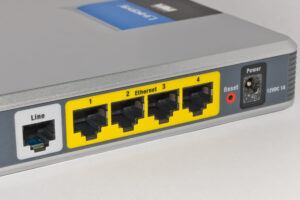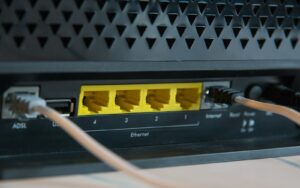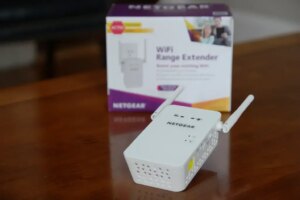Got spotty WiFi? If you need to decide between a WiFi mesh system, extender, booster, or repeater, you’ve come to the right place. These devices all improve WiFi coverage, but in different ways. Let’s break down the key differences so you can make the best choice for your home.
Here’s a quick answer to the question “WiFi mesh vs extender vs booster vs repeater”:
- WiFi mesh systems are the superior choice for whole-home coverage and seamless connectivity. If you have the budget and want the best speeds everywhere, they’re the way to go.
- WiFi extenders are a cost-effective option if you just need to improve signal in a specific room or area.
- WiFi boosters can work for a quick temporary fix, but they come with security risks.
- WiFi repeaters offer range extension but will likely cut your speeds significantly.
Want to know the details? Keep reading to understand which option is right for your specific needs!
WiFi Mesh vs. Extender vs. Booster vs. Repeater – Comparison Table
Here is a detailed comparison to help you choose the right option:
| WiFi Mesh | WiFi Extender | WiFi Booster | WiFi Repeater | |
|---|---|---|---|---|
| Cost | $$$ (Costliest) | $ | $ | $ |
| Ease of setup | Easy to moderate (app-based) | Easy | Very easy (plug and play) | Easy |
| WiFi standard support | Latest and fastest – WiFi 5, WiFi 6 | Up to WiFi 5 | Up to WiFi 5 | Up to WiFi 5 |
| Number of nodes | 3+ main router + nodes for coverage | 1 additional extender | 1 additional booster unit | 1 additional repeater |
| Coverage | Entire home – up to 5000 sq.ft. | Extend the range of routers by 15-30% further | Extend the range of routers by 50-70% further | Extend the range of routers 50-70% further |
| Band support | Dual or tri-band – 2.4GHz + 5GHz | Single or dual-band | Single or dual-band | Single or dual-band |
| Speed | Very fast – full speed of router | Moderate – shares router bandwidth | Moderate | Slow – half speed due to dual transmissions |
| Wired ports | 1+ LAN ports on all nodes | 1 LAN port typically | None | 1+ LAN ports |
| Latency | Very low | Low | Moderate | High |
| Seamless roaming | Single room or area ~1000 sq. ft. | No – Manual reconnect to optimal node | No | No – Must manually switch SSID |
| Wireless backhaul | Yes – dedicated wireless band connects nodes | No | No | No |
| Network authentication | WPA2/WPA3 security on the network | Hard-to-reach areas away from existing routers | Open network – insecure | Separate WPA2 network password |
| Expandability | Add nodes as needed | Limited to 1 extender typically | Limited to 1 booster unit | Limited to 1 repeater unit |
| Use cases | Large homes, smart homes, offices | Small dead zones like a room or floor | Temporary range boost | Yes – all nodes provide a single network |
In summary, while all these devices aim to improve your Wi-Fi coverage, in my opinion Wi-Fi mesh systems offer the most comprehensive solution with seamless coverage throughout your home.
Wi-Fi extenders, boosters, and repeaters are alternative options that can be effective in extending the range of your network but may require more manual setup and could potentially impact network speed.
Consider your coverage needs, budget, home size, and tech comfort when deciding which option may suit you best. Also, think about the number of wired and wireless devices on the network. Mesh systems really shine when managing many concurrent client gadgets.
Key Takeaways -WiFi Mesh vs Extender vs Booster vs Repeater
- 🌐 WiFi mesh systems create a unified wireless network throughout your home using multiple access points or nodes. This provides seamless coverage without dead zones.
- 🔗 WiFi extenders connect to your existing router wirelessly and rebroadcast the signal further into weak areas. They provide an affordable way to boost coverage.
- 🔊 WiFi boosters amplify weak router signals using high-gain antennas and broadcast them farther. However, they create an open, insecure network.
- 🔄 WiFi repeaters receive, amplify and retransmit your router’s WiFi signal as a separate wireless network. But this can halve bandwidth.
- 💰 Cost vs Performance: Mesh systems deliver superior performance and coverage but are pricier; extenders are more budget-friendly.
- 📡 Range Extension: Both boosters and repeaters significantly extend range but can introduce issues like interference.
- 🛠️ Upgrades and Optimization: Improving router performance involves upgrading hardware, optimizing placement, and using 5GHz bands.
- 📊 Decision Factors: Consider budget, coverage needs, and home size when choosing the right WiFi solution.
Now, let’s look into each device type in detail.
What is WiFi Mesh System?
A WiFi mesh system consists of multiple access points that work together to blanket your home with the strong WiFi signal. Unlike a traditional wireless router that only covers a limited range, mesh routers use multiple nodes placed around your house. This creates a seamless network without dead zones.
Key Advantages:
- Whole home coverage without dead spots
- Simple setup and management
- Mesh routers automatically switch client devices to the optimal node
- Support many devices without slowing down
Potential Drawbacks:
- More expensive than WiFi extenders and repeaters
- Require more Ethernet ports for optimal backhaul
- Nodes must be within range of each other
Mesh systems come in different configurations but typically include a main router connected to your modem and satellite nodes that plug into outlets around your home. A dedicated wireless band is used for communication between nodes while the other band(s) provide the actual WiFi network. Systems with tri-band support have even faster backhaul.
Leading options like the Linksys Velop, Netgear Orbi, and Eero Pro allow easy setup directly from a mobile app. You just need to place nodes around your house and plug them in. The system does the rest to provide you with seamless roaming and optimal performance.
With support for the latest WiFi standards like WiFi 6, mesh systems deliver incredibly fast wireless speeds to handle 4K streaming, gaming, video calls, and more, even with dozens of devices connected. Their range can cover large homes exceeding 4000 – 5000 sq. ft. When expanding your network, just add another node instead of getting a new router.
Mesh WiFi is ideal if you have consistent dead zones in your home or need wider coverage for smart home devices. It may be overkill for smaller apartments which work fine with a single wireless router. Here are some of the best WiFi Mesh systems.
Wifi Mesh vs Repeater
Mesh systems and repeaters both extend WiFi coverage, but in different ways. Mesh systems consist of multiple nodes working together to create a seamless, unified network across a large area. They automatically route data efficiently, maintaining high speeds and eliminating dead zones.
Repeaters, on the other hand, simply amplify and retransmit an existing WiFi signal. They can extend the network’s range but often at the cost of halving bandwidth and potentially creating a separate network SSID, which can complicate device connectivity.
What is a WiFi Extender?
A WiFi extender is a device that connects to your existing router wirelessly and rebroadcasts the signal further into areas it cannot reach normally. Unlike expensive mesh systems, extenders provide an affordable way to boost WiFi coverage within a limited budget.
Key Benefits of WiFi Extenders:
- Inexpensive solution for improving WiFi range
- Easy to set up for non-technical users
- Small footprint and wall-plug design
- Can connect to both 2.4GHz and 5GHz WiFi bands
Potential Weaknesses:
- Dependent on the main router’s signal strength
- Bandwidth is shared with the main router
- Fewer LAN ports for wired connections
- Can’t switch connections between nodes
There are two main types of WiFi extenders:
Single-band extenders that only amplify 2.4GHz signals and dual-band models that also boost 5GHz networks. Dual-band is preferable since it provides faster speeds. Position your extender halfway between your wireless router and the dead zone you want to reach.
Leading WiFi extender brands like TP-Link, D-Link, and Netgear offer compact wall-plug extenders that are easy to set up for average consumers. Using WPS or web interfaces, you can wirelessly connect the extender to your existing WiFi. Some models even have Ethernet ports to connect wired devices.
WiFi extenders work best for a single dead zone rather than whole home coverage. Place them strategically to amplify signals to that weak area. They are also great temporary solutions when you move your router. Below are some of the best WiFi extenders with ethernet ports.
What are mesh wifi extenders?
Mesh WiFi extenders are components of a mesh network system designed to provide comprehensive WiFi coverage in an area. Unlike traditional WiFi extenders, mesh extenders do not create separate network names (SSIDs); instead, they work together as part of a single network. Each extender, often called a node, communicates with the others to spread a strong, consistent WiFi signal across the entire coverage area.
This system ensures seamless connectivity, allowing devices to automatically connect to the strongest signal without manual switching, making it ideal for eliminating dead zones in large or multi-story homes.
How do wifi mesh extenders work?
WiFi mesh extenders work by creating a network of nodes that collectively blanket an area with WiFi coverage, eliminating dead zones. Each node communicates with the others, forming a single, seamless network.
Unlike traditional extenders, which simply rebroadcast the existing signal and can reduce bandwidth, mesh nodes communicate using a dedicated wireless band. This setup allows for more efficient data routing, reduces signal loss, and maintains higher speeds throughout the network. Mesh systems are particularly effective in larger homes or areas where a single router’s signal would be insufficient.
What are WiFi Boosters?
WiFi boosters or signal amplifiers are devices that capture weak WiFi signals from your router and retransmit them more powerfully to extend the range. They do not actually connect to or communicate with the router, simply broadcasting the same SSID and password in areas with poor coverage.
Key Benefits of WiFi Boosters:
- Very easy plug-and-play setup
- Compact wall-plug design
- An affordable way to extend the WiFi range
- Utilize high-gain antennas to amplify signals
Potential Limitations:
- Security risks from open WiFi access
- Can create signal interference
- Unreliable connectivity between devices
- Lack of WPA encryption
WiFi boosters essentially operate like a megaphone for your wireless signal. Using powerful high-gain antennas and amplifiers, they can broadcast the signal up to twice as far as your router’s range. However, since they do not actually connect to the network, there can be interference and performance issues.
Leading options from brands like GoFanco use dual or tri-band support to target dead zones, specifically in 2.4GHz or 5GHz bands. Because they create an open network, some IT experts warn about potential security risks. Hence placement is important to limit outside access.
Boosters provide a quick extension range without much setup. But mesh systems and extenders provide better performance, encryption, and handoff between access points. Only use boosters for small dead zones or temporary situations.
What is a WiFi Repeater?
WiFi repeaters work by receiving an existing WiFi signal, amplifying it, and retransmitting the boosted signal. Unlike range extenders which retain the same network name, repeaters create an entirely new wireless network with a different SSID and password.
Key Advantages of WiFi Repeaters:
- Can extend network range considerably
- Flexible placement for optimal coverage
- Affordable solution for home use
- Often have built-in signal amplifiers
Potential Weaknesses:
- Halves the available bandwidth
- Different SSID can cause device issues
- Adds latency from multiple retransmissions
- Security risks from new open WiFi network
Setting up a repeater involves connecting to your existing WiFi, amplifying the signal strongly, and rebroadcasting it as a new network. You connect clients to this new SSID in the extended range. The main drawbacks are halved bandwidth, latency from dual transmissions, and an additional network to manage.
Leading options like the D-Link DAP-1610 use powerful amplified antennas and support the fastest WiFi standards. Additional software features like AP steering help manage performance across nodes. Place repeaters strategically to avoid interference while maximizing extended coverage.
For best connectivity, only connect to the repeater network when in its extended range. Turn off its radios if they interfere with your main router network. Repeaters provide further coverage than range extenders, but mesh systems are more seamless.
Additional Tips for Optimal WiFi
Whichever solution you choose, also adopt these tips for stronger day-to-day WiFi in your environment:
- Optimally place your wireless router/access points centrally in the home and away from obstructions. Walls and objects can weaken signals.
- Choose the 5GHz WiFi band whenever available for faster speeds and less interference. 5GHz has a shorter range but higher throughput.
- Upgrade routers and devices to the latest WiFi standards like WiFi 5 and WiFi 6 for faster network speeds. But ensure compatibility among nodes.
- Reduce wireless interference by keeping home electronics like microwaves away from your router. Neighbor WiFi networks can also cause interference.
- Set distinct non-overlapping channels for any 2.4GHz network. Neighboring routers should use channels 1, 6, or 11.
- Analyze your coverage with WiFi analytics tools to find dead zones that need help. Consider a WiFi site survey.
- Use a wireless mesh if building materials like concrete, thick walls, or long distances weaken signals considerably.
- Replace old routers that may lack the necessary power and features like beamforming for wider coverage.
The good news is with today’s technology; there are more ways than ever to banish dead zones and get better WiFi reach in your home. A quick upgrade like a mesh node, extender, or repeater can completely transform your wireless experience.
If you’re curious about the practical implications of internet speeds, the below posts will provide a comprehensive analysis.
- Is 10 Mbps fast Enough?
- The Ultimate Guide to 200 Mbps Internet Speed: Is 200 Mbps Fast Enough
- Is 500 Mbps Fast? Exploring Internet Speeds and Performance
- Is 600 Mbps Fast Internet Speed?
- Is 1000 Mbps Fast Internet? (The Gold Standard of Internet Speeds)
Which WiFi Extenders are Compatible with Starlink in 2023?
Are you wondering which WiFi extenders are compatible with Starlink in 2023? There are several options available to enhance your Starlink experience. Explore starlink compatible wifi extenders that offer seamless connectivity and reliable performance. With the right extender, you can amplify your Starlink signal and enjoy fast and stable internet throughout your home or office.
To Conclude
So, what’s the best way to banish WiFi dead zones?
- WiFi Mesh: Best for whole-home coverage, seamless connectivity, and handling lots of devices, but costly.
- WiFi Extender: Budget-friendly solution to expand the range of your existing router.
- WiFi Booster: Amplifies a weak signal but creates a less secure network.
- WiFi Repeater: Extends range but can cut your internet speed in half.
Think carefully about your budget, the size of your home, and the number of devices using WiFi. If you still have questions or need more tailored advice, feel free to leave a comment!
Frequently Asked Questions (FAQs)
What are the disadvantages of a mesh network?
Here are the disadvantages of a Mesh Network.
- More expensive than WiFi extenders or repeaters
- Can be complex to set up and manage
- Multiple nodes are required so more hardware
- Wireless backhaul can create latency
Is it worth upgrading to mesh WiFi?
Upgrading to mesh can be worth it if you need wider coverage across a large home, a unified network, robust smart home connectivity, or to eliminate frustrating dead zones.
Is WiFi mesh worth it?
Mesh WiFi is worth the investment if you need whole home coverage without dead spots, strong wireless performance for many devices, and reliable connectivity in every room.
Does WiFi mesh reduce speed?
Mesh can slightly reduce speed versus a single router since bandwidth is shared between nodes. But with the latest standards like WiFi 6, tri-band, and wired backhaul, the speed reduction is minimal while coverage improves.











